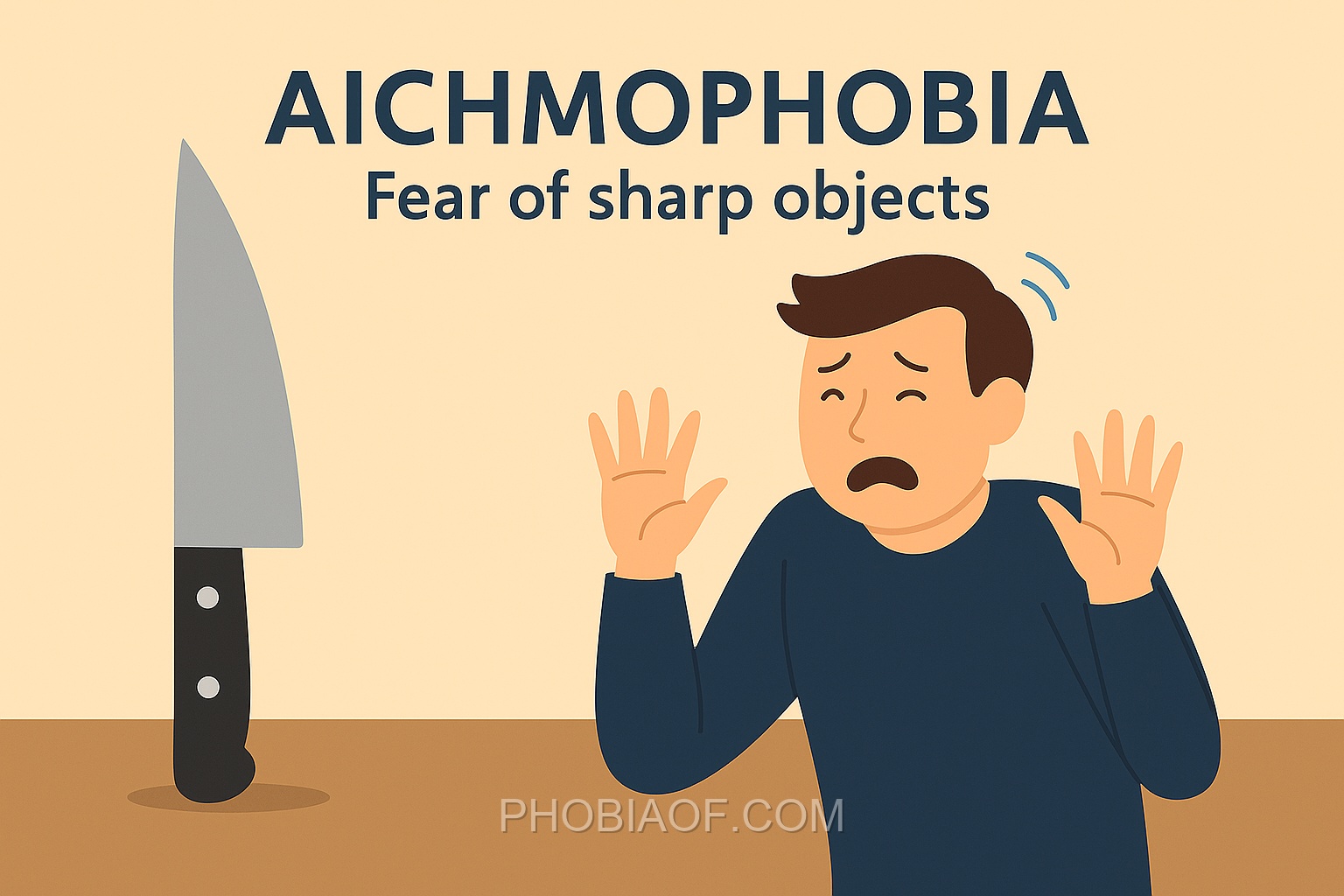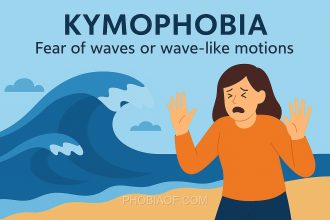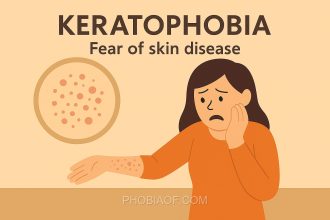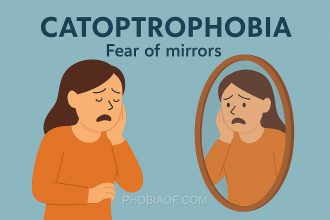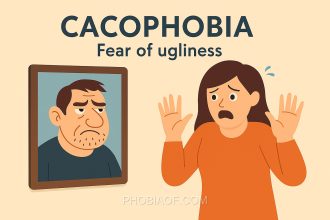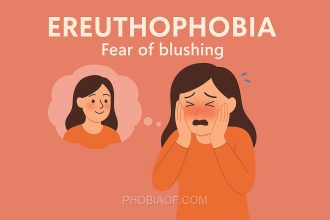Have you ever felt a shiver down your spine at the mere sight of a needle, or found yourself instinctively backing away from a pair of scissors? If so, you’re not alone, and you might be experiencing what’s known as Aichmophobia.
Aichmophobia is the intense fear of sharp objects. This includes everyday items such as needles, knives, or even pencils. The term comes from the Greek word “aichmē,” meaning point or edge, and “phobia,” meaning fear. While many people might feel a slight discomfort around sharp objects, those with aichmophobia experience overwhelming anxiety that can interfere with daily life.
People with aichmophobia might go to great lengths to avoid situations where they might encounter sharp objects. This phobia can manifest in various ways, including:
- Avoiding medical procedures that involve needles.
- Experiencing panic attacks at the sight of sharp objects.
- Feeling excessive worry even when thinking about sharp objects.
Understanding and addressing aichmophobia is important, as it can significantly impact one’s quality of life. If you or someone you know struggles with this fear, seeking professional help can provide strategies to manage and alleviate the anxiety associated with sharp objects.
Causes of Aichmophobia
Aichmophobia is the intense fear of sharp objects such as needles, knives, or even pointed corners of furniture. Understanding why someone might develop this fear can involve exploring various influences, including genetic, psychological, and environmental factors.
- Genetic Predisposition:
Some people may have a genetic predisposition to anxiety disorders, including specific phobias like aichmophobia. Family history can play a role, suggesting that genetics might influence the likelihood of developing such fears.
- Traumatic Experiences:
A past traumatic event involving sharp objects can lead to aichmophobia. For instance, a painful experience with needles during a medical procedure might trigger this fear. The brain associates the object with pain and danger, leading to heightened anxiety when confronted with similar situations.
- Learned Behavior:
Observing others who display a fear of sharp objects can also contribute to developing aichmophobia. Children, in particular, can learn and internalize fears from parents or caregivers who exhibit anxiety around these objects.
- Psychological Factors:
Underlying anxiety disorders or heightened sensitivity to stress can exacerbate fears, making individuals more susceptible to developing phobias like aichmophobia. This is often intertwined with personal psychological vulnerabilities.
- Environmental Influences:
Environmental factors such as cultural attitudes towards sharp objects, as well as media portrayals of them as dangerous, can influence the development of this phobia. Persistent exposure to negative messages about sharp objects can reinforce fear.
Interestingly, some research suggests that phobias, including aichmophobia, might be an evolutionary response. Historically, sharp objects could pose real danger, so a heightened instinctual response might have been advantageous for survival. While this theory provides a broad understanding, individual experiences and contexts remain crucial in the development of aichmophobia.
Symptoms of Aichmophobia
Aichmophobia, the fear of sharp objects, manifests through intense fear or anxiety when an individual is exposed to or even thinks about sharp objects such as knives, needles, or scissors. This phobia can present a range of physical and emotional symptoms, which can impact daily functioning.
Physical Symptoms:
- Experiencing panic attacks when confronted with sharp objects.
- Excessive sweating, particularly when near or thinking about sharp items.
- A rapid heartbeat or palpitations in the presence of triggers.
- Shortness of breath or tightness in the chest when faced with sharp objects.
- Trembling or shaking at the sight or thought of sharp instruments.
- Feeling dizzy or lightheaded around sharp objects.
Emotional and Behavioral Symptoms:
- An overwhelming sense of dread when anticipating exposure to sharp objects.
- Avoidance of situations where sharp objects might be present, such as avoiding kitchens or medical settings.
- Intense anxiety or distress even when thinking about sharp objects.
- Feeling a loss of control or helplessness when confronted with sharp objects.
- Constantly worrying about encountering sharp objects in daily life.
When severe, the symptoms of Aichmophobia can significantly interfere with daily activities, making it challenging to engage in routine tasks or social interactions.
Treatment for Fear of Sharp Objects (Aichmophobia)
Overcoming aichmophobia, or the fear of sharp objects, is entirely possible with the right treatment and coping strategies. This phobia, like many others, can be treated and managed effectively over time. With dedication and the right support, you can regain control over your life and reduce the fear that sharp objects may bring.
Here are some proven therapies and coping strategies to consider:
- Exposure Therapy:
This therapy involves gradually and systematically exposing yourself to the fear of sharp objects in a controlled and safe manner. Starting with less intimidating situations and progressively working up to more challenging situations can help to desensitize your fear response. Over time, this can reduce the intensity of your phobia.
- Cognitive-Behavioral Therapy (CBT):
CBT focuses on identifying and changing the negative thought patterns that fuel your fear of sharp objects. By working with a therapist, you can learn to reframe these thoughts, develop healthier responses, and diminish the hold the phobia has on your life.
- Counseling:
Talking with a mental health professional can provide support and guidance as you navigate your phobia. Counseling can help you explore the root causes of your fear and develop personalized strategies for managing it.
In addition to therapy, there are several self-help coping techniques that you can incorporate into your daily routine:
- Relaxation Exercises:
Practicing relaxation techniques such as deep breathing, progressive muscle relaxation, or guided imagery can help to calm your mind and reduce anxiety related to sharp objects.
- Meditation:
Regular meditation can improve your overall mental well-being, increase mindfulness, and help you manage your fear response more effectively.
- Support Groups:
Connecting with others who share similar experiences can provide comfort and understanding. Support groups offer a safe space to share your journey, exchange coping strategies, and receive encouragement.
In severe cases, medication such as anti-anxiety medications might be prescribed to help manage intense symptoms. However, therapy and coping skills are the primary focus for long-term improvement.
If aichmophobia is interfering with your daily life, it’s important to seek professional help. A mental health expert can guide you through the most suitable treatment options and support you in overcoming your fears.
Remember, you are not alone, and with the right approach, you can conquer your fear of sharp objects and lead a more fulfilling life.
Conclusion
Understanding the causes and symptoms of Aichmophobia is a crucial first step in addressing this challenging phobia. By recognizing the triggers and manifestations, individuals can better equip themselves to confront their fears and seek appropriate interventions. Knowledge empowers, and with this awareness, those affected by Aichmophobia are more likely to take actionable steps towards managing their fear effectively.
It is important to remember that many people successfully overcome or manage their phobias over time with the right support and treatment. If you or someone you know is struggling with Aichmophobia, consider reaching out to a mental health professional or talking to a doctor for guidance and support. Therapy can offer valuable strategies and tools to help you cope and regain control over your life.
Stay hopeful and proactive in your journey towards overcoming Aichmophobia. With patience, determination, and the right help, you can reduce anxiety and lead a more fulfilling life.
